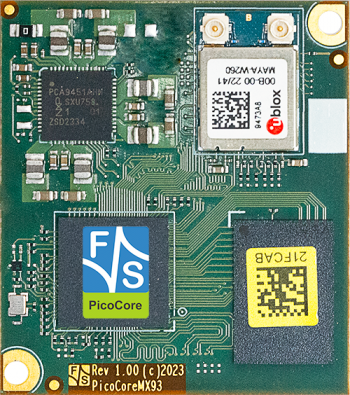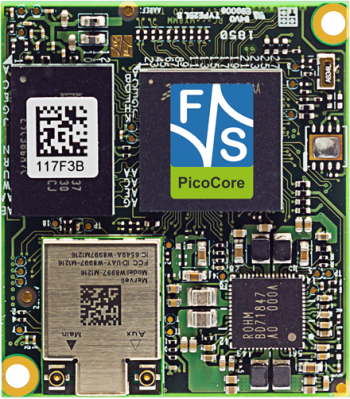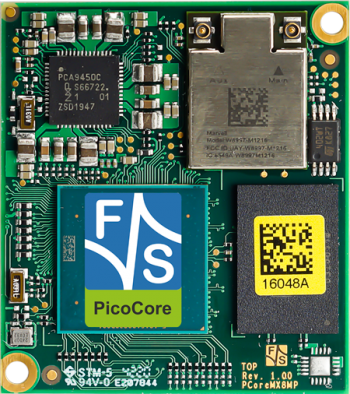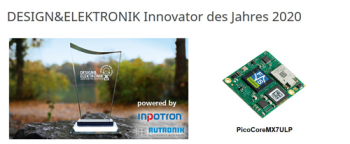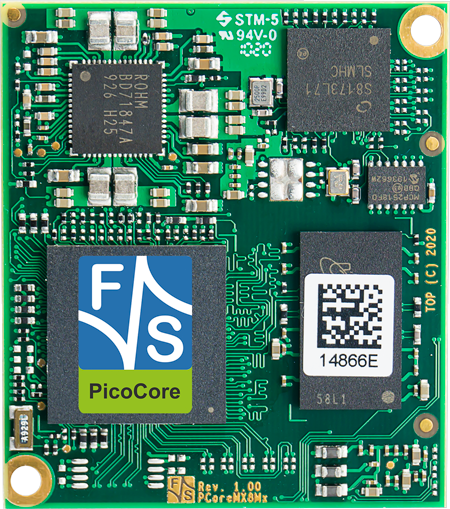PicoCore™
Computer on Module Produktfamilie
| PicoCore™MX6UL100 | PicoCore™MX8MN | PicoCore™MX8MM | PicoCore™MX8MP | PicoCore™MX91 | PicoCore™MX93 | PicoCore™MX8ULP | |
| Status | Production | Production | Production | Production | Samples | Production | Samples |
| CPU | - | - | - | - | - | - | - |
| Typ | NXP i.MX 6ULL | NXP i.MX 8M Nano | NXP i.MX 8M Mini | NXP i.MX 8M Plus | NXP i.MX 91 | NXP i.MX 93 | NXP i.MX 8ULP |
| Kern | ARM Cortex-A7 | ARM Cortex-A53 Cortex-M7 |
ARM Cortex-A53 Cortex-M4 |
ARM Cortex-A53 Cortex-M7 HiFi-4 DSP, NPU, ISP |
ARM Cortex-A55 | ARM Cortex-A55 Cortex-M33 NPU |
ARM Cortex-A35 Cortex-M33 Hifi 4 DSP |
| Anzahl Kerne | 1 | 4x A53 + 1x M7 | 4x A53 + 1x M4 | 4x A53 + M7 | 1x A55 | 2x A55 + M33 + NPU | 2x A35 + 1x M33 + DSP |
| Frequenz | max. 900MHz | max. 1.5GHz + 650MHz | max. 1.8GHz + 400MHz | max. 1.8GHz + 800MHz | 1.4GHz | 1.7GHz + 250MHz | 800MHz + 216MHz + 600MHz |
| L2-Cache | 128KB | 512KB | 512KB | 512kB | 256kB L2 | 2x64kB L2 + 256kB L3 | 512kB |
| NPU | - | - | - | 2.3 TOPS | - | 0.5 TOPS | - |
| GPU | - | 2D/3D GC7000 UltraLite (2 shader) | 2D GC328, 3D GCNanoUltra (1 shader) | 2D, 3D: ES 3.1/3.0, CL™ 1.2, VG™ 1.1 | - | PXP | 2D, 3D: ES™ 3.1, CL™, VG™ 1.1 |
| VPU | - | - | Decode: 1080p60 HEVC/H.265, H.264, VP9, VP8 Encode: 1080p60 H.264, VP8 |
Decode: 1080p60 H.265, H.264, VP9, VP8 Encode: 1080p60 H.265, H.264 |
- | - | - |
| Security | - | - | - | - | - | - | - |
| Secure Element | SE050 | - | SE050 | SE050 | Edgelock Secure Enclave | Edgelock Secure Enclave | Edgelock Secure Enclave |
| Betriebssystem | - | - | - | - | - | - | - |
| Linux | Buildroot/ Yocto (uboot installed) |
Buildroot/ Yocto (uboot installed) |
Buildroot/ Yocto (uboot installed) |
Yocto (uboot installed) |
Yocto (uboot installed) |
Yocto (uboot installed) |
Yocto (uboot installed) |
| Windows | - | - | - | 10 IoT Enterprise (UEFI installed) |
- | 11 IoT Enterprise (UEFI installed) |
- |
| Echtzeit | - | FreeRTOS | FreeRTOS | FreeRTOS | - | FreeRTOS | FreeRTOS |
| Speicher | - | - | - | - | - | - | - |
| Flash | max. 512MB SLC NAND EEPROM |
max. 512MB SLC NAND EEPROM |
max. 512MB SLC NAND EEPROM |
EEPROM | EEPROM | EEPROM | 2 kbit EEPROM |
| eMMC | max. 32GB | max. 64GB | max. 64GB | max. 64GB | max. 64GB | max. 64GB | max. 64GB |
| RAM | 512MB DDR3L | max. 2GB LPDDR4 x16 | max. 4GB LPDDR4/ DDR3L | max. 8GB LPDDR4 x32 |
max. 2GB LPDDR4 x16 |
max. 2GB LPDDR4 x16 |
max. 2GB LPDDR4 x32 |
| Schnittstellen | - | - | - | - | - | - | - |
| SD-Karte | 1x SDIO | 2x extern | 2x extern | 2x SDIO | 2x SDIO | max. 2x SDIO | max. 2x SDIO |
| Ethernet | max. 2x 100 Mb opt. RMII |
max. 2x 100/1000Mb opt. RGMII |
max. 2x 100/1000Mb opt. RGMII |
2x 100/1000Mb opt. RGMII |
max. 2x 100/1000Mb opt. 1x RGMII |
max. 2x 100/1000Mb opt. RGMII |
1x 100Mb opt. RMII |
| WLAN | 802.11 ac/a/b/g/n (2.4/ 5GHz) |
802.11 ac/a/b/g/n (2.4/ 5GHz) |
802.11 ac/a/b/g/n (2.4/ 5GHz) |
802.11 ac/a/b/g/n (2.4/ 5GHz) |
WIFI 6 (2.4/ 5GHz) |
WIFI 6 (2.4/ 5GHz) |
802.11 ac/a/b/g/n (2.4/ 5GHz) |
| BT | 5.3 | 5.3 | 5.3 | 5.3 | 5.4 | 5.4 | 5.3 |
| USB Host | 1x 2.0 | - | 1x | 1x 3.0 | 1x 2.0 | 1x 2.0 | 1x 2.0 |
| USB Device | 1x OTG 2.0 | 1x OTG 2.0 | 1x OTG 2.0 | 1x OTG 3.0 | 1x OTG 2.0 | 1x OTG 2.0 | 1x OTG 2.0 |
| CAN | 2x FlexCAN | 1x CAN-FD | 1x CAN-FD | max. 2x | max. 2x CAN-FD | max. 2x CAN-FD | 1x FlexCAN |
| UART | max. 4x | max. 4x | max. 4x | max. 4x | max. 8x | max. 8x | max. 4x |
| I2C | max. 4x | max. 4x | max. 4x | max. 4x | max. 4x | max. 4x | max. 4x |
| SPI | max. 2x | max. 2x | max. 2x | max. 2x | max. 2x | max. 2x | max. 2x |
| Audio | Line In/ Out/ Mic/ Headphone opt. I2S |
Line In/ Out/ Mic/ Headphone opt. I2S |
Line In/ Out/ Mic/ Headphone opt. I2S |
Line In/ Out/ Mic/ Headphone opt. I2S |
Line In/ Out/ Mic/ Headphone opt. I2S |
Line In/ Out/ Mic/ Headphone opt. I2S |
Line In/ Out/ Mic/ Headphone opt. I2S |
| Digital I/O | |||||||
| ADC | - | - | - | - | 4x | 4x | 2x (12 Bit) |
| Touch Panel | via I2C or USB | via I2C or USB | via I2C or USB | via I2C or USB | via I2C or USB | via I2C or USB | via I2C or USB |
| Kamera | - | MIPI CSI | MIPI CSI | 2x MIPI-CSI (4 lanes) |
- | MIPI-CSI (2 lanes) |
MIPI-CSI (2 lanes) |
| PCIe | - | 1x | 1x | 1x PCIe 3.0 (1 lane) |
- | - | - |
| RTC | PCF85263ATL | PCF85263ATL | PCF85263ATL | PCF85263ATL | PCF85263ATL | PCF85263ATL | PCF85263ATL |
| sonstige Schnittstellen | max. 4x PWM, SPDIF, ESAI, SAI, SSI |
max. 4x PWM, SPDIF, ESAI, SAI, SSI | max. 4x PWM, Watchdog, SPDIF, ESAI, SAI, SSI |
max. 4x PWM, SPDIF, ESAI, SAI, SSI | max. 4x PWM, SPDIF, ESAI, SAI, SSI, TAMPER | max. 4x PWM, SPDIF, ESAI, SAI, SSI | PWM, Watchdog SPDIF/DMIC |
| Display | - | - | - | - | - | - | - |
| RGB | 18 Bit | - | - | - | 18 Bit | 18 Bit | 24 Bit |
| LVDS | 1x 4 Lanes | 2x 4 Lanes | 2x 4 Lanes | 2x 4 lanes | - | 1x 4 Lanes | 1x 4 Lanes |
| CRT/DVI | - | - | - | DVI | - | - | - |
| MIPI-DSI | - | 1x 4 Lanes | 1x 4 Lanes | 1x 4 lanes | - | 1x 4 Lanes | 1x 4 Lanes |
| Allgemein | - | - | - | - | - | - | - |
| V_IN | +4.5V - 5.5VDC | +4.5V - 5.5VDC | +4.5V - 5.5VDC | +4.5V - 5.5VDC | +4.5V - 5.5VDC | +4.5V - 5.5VDC | +4.5V - 5.5VDC |
| T_AMB | 0°C - +70°C -20°C - +85°C -40°C - +85°C |
0°C - +70°C -25°C - +85°C -40°C - +85°C |
0°C - +70°C -25°C - +85°C -40°C - +85°C |
0°C - +70°C -25°C - +85°C -40°C - +85°C |
0°C - +70°C -25°C - +85°C -40°C - +85°C |
0°C - +70°C -25°C - +85°C -40°C - +85°C |
0°C - +70°C -25°C - +85°C -40°C - +85°C |
| Größe | 35x40mm | 35x40mm | 35x40mm | 35x40mm | 35x40mm | 35x40mm | 35x40mm |
| Verfügbarkeit | 2035+ | 2034 | 2034+ | 2036+ | 2040+ | 2038+ | 2038+ |
| PicoCore™MX6UL100 | PicoCore™MX8MN | PicoCore™MX8MM | PicoCore™MX8MP | PicoCore™MX91 | PicoCore™MX93 | PicoCore™MX8ULP |
Der kompakte Computer on Module Formfaktor PicoCore™ zeichnet sich durch seine geringe Größe von nur 35 x 40 mm und einem sehr geringen Board-to-Board Abstand ab 1,5mm aus.
PicoCore™ System on Modules eignen sich ideal für kleine und stromsparende Prozessoren von NXP, wie i.MX 8M Mini/ Nano oder i.MX 8M Plus.
Die PicoCore™ embedded Module zeichnen sich durch Robustheit, geringe Verlustleistung und hohe Performance aus und sind bestens geeignet für tragbare Geräte in der Medizin- und Industrietechnik, Multimediaanwendungen oder auch für sichere Cloudverbindungen.
Auf dem ARM-basierten PicoCore™ Formfaktor stehen bis zu 4 Cortex®-A53 Kerne und ein Cortex®-M4/M7 Kern zur Verfügung. Eine 1080p Hardware Videobeschleunigung zur Umsetzung von Zwei-Weg Videoapplikationen und eine integrierte 3D und 2D Hardwarebeschleunigung sind im Prozessor enthalten.
Als Speicher werden SLC NAND Flash und alternativ auch eMMC angeboten. Die zwei 100-poligen Steckverbinder ermöglichen eine Vielzahl an Schnittstellen wie 2x SD-Card Slot, 1-2 Gigabit Ethernet, 2x USB, CAN, 4x I2C, 2x SPI, 4x UART, Audio (Line In/ Out/ Mic/ Headphone oder I2S), PCIe, GPIO, PWM und MIPI-CSI für Kameraanbindung. Als Displayanschluss ist eine MIPI-DSI oder alternativ oft auch LVDS 24 Bit Schnittstelle vorgesehen, bei der auf NXP i.MX 8M Plus basierenden PicoCore™MX8MP zusätzlich noch DVI.
Zum Anschluss eines Touchpanels wird I2C verwendet. Optional steht bei einigen Versionen auch ein WLAN/ BT Modul zur Verfügung.
Wir unterstützen Sie optimal bei Ihrer Softwareentwicklung. Für jedes PicoCore™ Modul stehen umfangreiche, sofort lauffähige Development Kits mit Display zur Verfügung.
Die F&S Ingenieure leisten Support via Forum, Telefon und E-Mail. Des Weiteren bieten wir umfangreiche Leistungen in den Bereichen Over-The-Air Update, Secure Boot, Asymmetrisches Multiprocessing und vielem mehr.
 |
Starterkit PicoCore™MX6UL100 Linux PicoCore™MX6UL-V4-LIN, Basisboard, 7" LVDS Display, Kabelkit, Zugangsdaten zu Dokumentation und Software Bestellnr.: PCoreMX6UL100-SKIT-LIN |
360,- € | ||
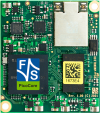 |
RGB Starterkit PicoCore™MX6UL100 Linux PicoCore™MX6UL-V1I-LIN, Basisboard, 7"RGB Display, Kabelkit, Zugangsdaten zu Dokumentation und Software Bestellnr.: PCoreMX6UL100-SKIT2 |
360,- € |
 |
Starterkit PicoCore™MX8MM Linux PicoCore™MX8MM-V14I-LIN, Basisboard, Display, Kabelkit, Zugangsdaten zu Dokumentation und Software Bestellnr.: PCoreMX8MM-SKIT2 |
360,- € |
 |
Starterkit PicoCore™MX8ULP Linux Evaluation Kit PicoCore™MX8ULP mit Basisboard, MIPI-DSI zu LVDS Adapter, 7" LVDS Display, Kabelkit, Zugangsdaten zu Dokumentation und Software Bestellnr.: PCore8ULP-SKIT-LIN |
360,- € |
 |
Starterkit PicoCore™MX8MP Linux NXP i.MX 8M Plus Evaluation Board PicoCore™MX8MP-V4I-LIN, Basisboard, Display, Kabelkit, Zugangsdaten zu Dokumentation und Software Bestellnr.: PCoreMX8MP-SKIT-LIN |
360,- € | ||
 |
Starterkit PicoCore™MX8MP Windows 10 IoT NXP i.MX8M Plus with Windows 10 IoT evaluation kit. Includes carrier board, 7" LVDS PCAP display and access to software and documentation. Bestellnr.: PCoreMX8MP-SKIT-W10 |
360,- € |
 |
Starterkit PicoCore™MX93 Linux PicoCoreMX93 mit Baseboard und Kabel, inkl. PicoCoreMX93, Trägerplatine, Kabel-Kit, 7“ LVDS-Display mit PCAP Touch und Kabel-Kit, Zugang zu Dokumentation und Software Bestellnr.: PCoreMX93-SKIT-LIN |
360,- € | ||
 |
Starterkit PicoCore™MX93 Windows IoT 11 PicoCoreMX93 mit Baseboard und Kabel, Trägerplatine, Kabel-Kit, 7“ LVDS-Display mit PCAP Touch und Kabel-Kit, Zugang zu Dokumentation und Software Bestellnr.: PCoreMX93-SKIT-W11 |
360,- € | ||
 |
Starterkit PicoCore™MX93 AI Linux AI Evaluationskit: PicoCoreMX93 mit NPU, Trägerplatine, 7“ LVDS-Display mit PCAP Touch und Kabel-Kit, MIPI-CSI Kamera mit ISP, Zugang zu Dokumentation und Software, CRA ready, Secure Boot, Over-The-Air oder lokales Update Bestellnr.: PCoreMX93-SKIT-AI |
480,- € |
| Architektur | Typ | Release Name | NBoot | Bootloader | UEFI | Kernel | OS | Help File | Software | VM |
|---|---|---|---|---|---|---|---|---|---|---|
| FSIMX8MM | FreeRTOS | fsimx8mm-V2021.07 | sdk-2.9.1 |
|
||||||
| FSIMX8MM | Yocto | osm8mm-Y2024.10.1 | U-Boot 2021.04 | Linux 5.15.160 | Yocto 4.0.20 Kirkstone | |||||
| FSIMX8MM | Yocto | fsimx8mm-Y2023.10 | U-Boot 2021.04 | Linux 5.15.131 | Yocto 4.0 Kirkstone | |||||
| FSIMX8MM | Buildroot | fsimx8mm-B2023.11 | U-Boot 2021.04 | Linux 5.15.131 | Buildroot 2023.02.06 |
| Architektur | Typ | Release Name | NBoot | Bootloader | UEFI | Kernel | OS | Help File | Software | VM |
|---|---|---|---|---|---|---|---|---|---|---|
| FSIMX8MN | Yocto | fsimx8mn-Y2024.02 | U-Boot 2021.04 | Linux 5.15.148 | Yocto 4.0 Kirkstone |
| Architektur | Typ | Release Name | NBoot | Bootloader | UEFI | Kernel | OS | Help File | Software | VM |
|---|---|---|---|---|---|---|---|---|---|---|
| FSIMX8MP | Yocto | fsimx8mp-Y2025.12 | U-Boot 2024.04 | Linux 6.6.112 | Yocto 5.0.14 Scarthgap | |||||
| FSIMX8MP | Windows | iMX8MP_W10_V120 | nboot-fsimx8mp-iot-2024.06.1 | U-Boot uboot-fsimx8mp-iot-2024.08 | uefiIMX8MP_X_12 | 1.2 | Windows 10 Iot LTSC 2021 |
|
||
| FSIMX8MP | FreeRTOS | fsimx8mp-V2024.09 | sdk-2.15.0 |
|
||||||
| FSIMX8MP | Yocto | fsimx8mp-Y2024.07 | U-Boot 2021.04 | Linux 5.15.160 | Yocto 4.0 Kirkstone |
| Architektur | Typ | Release Name | NBoot | Bootloader | UEFI | Kernel | OS | Help File | Software | VM |
|---|---|---|---|---|---|---|---|---|---|---|
| FSIMX6UL | Buildroot | fsimx6ul-B2023.12 | U-Boot 2021.04 | Linux 5.15.131 | Buildroot 2023.02.06 | |||||
| FSIMX6UL | Yocto | fsimx6ul-Y2024.03.1 | U-Boot 2021.04 | Linux 5.15.185 | Yocto 4.0.29 Kirkstone |
| Architektur | Typ | Release Name | NBoot | Bootloader | UEFI | Kernel | OS | Help File | Software | VM |
|---|---|---|---|---|---|---|---|---|---|---|
| FSIMX91 | Yocto | fsimx91-Y2024.09-pre | U-Boot 2024.04 | Linux 6.6.xx | Yocto 5.0 Scarthgap |
|
|
|
| Architektur | Typ | Release Name | NBoot | Bootloader | UEFI | Kernel | OS | Help File | Software | VM |
|---|---|---|---|---|---|---|---|---|---|---|
| FSIMX93 | Windows | iMX93_W11_V120 | nboot-fsimx93-iot-2025.05 | U-Boot uboot-fsimx93-iot-2025.05pre.fs | uefiIMX93_X_12 | 1.2 | Windows 11 Iot LTSC 2024 |
|
||
| FSIMX93 | Yocto | fsimx93-Y2025.08 | U-Boot 2024.04 | Linux 6.6.101 | Yocto 5.0.11 Scarthgap |
|
| Architektur | Typ | Release Name | NBoot | Bootloader | UEFI | Kernel | OS | Help File | Software | VM |
|---|---|---|---|---|---|---|---|---|---|---|
| FSIMX8ULP | Yocto | fsimx8ulp-Y2025.11 | U-Boot 2024.04 | Linux 6.6.112 | Yocto 5.0.13 Scarthgap |
|


